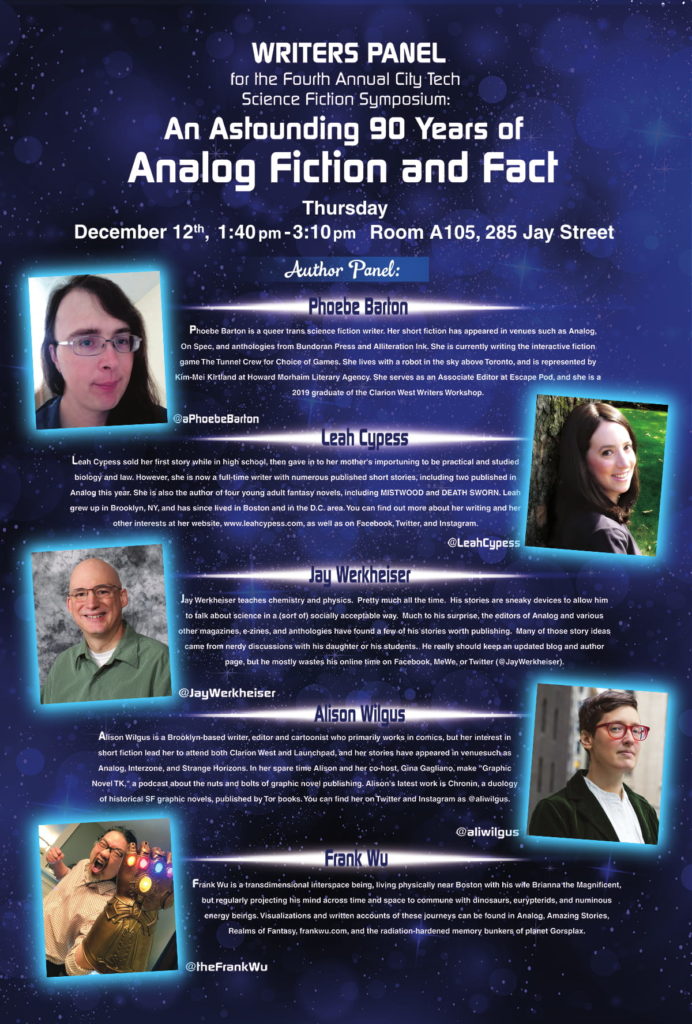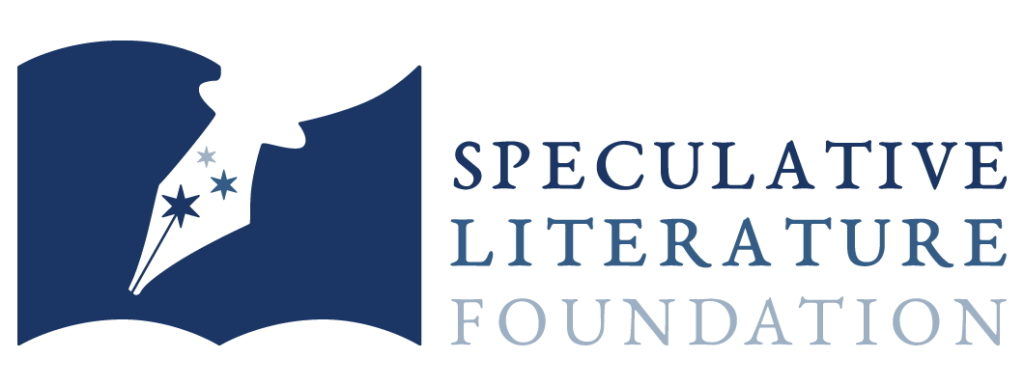(1) BURKE TELLS MORE ABOUT HER BALTICON EXPERIENCE. Stephanie Burke has written a 2600-word comment on File 770’s “Balticon Chair Apologizes After Author Stephanie Burke Removed From Panels” post that goes into fuller detail about her experience. The link is here. In the last two paragraphs she says —
…It took me close to 20 years to build up my reputation there as a person who did her best to make sure everyone had representation, that willful ignorance would be avoided, to be someone who was safe for anyone to speak to, to offer info, links, and some perspective that may help them as well as learn how I can improv myself, and now it is gone here with no proof and no way to defend myself. All I got was the decision of the board still stands and I still don’t have an idea of what exactly I was supposed to have said. They told me they didn’t have the recordings in the room where ever panel was recorded so unless someone is lying about the recording, I’ll never get the chance to defend myself. Unless of course, the recording is found at the last moment but to me that sounds like looking for proof of guilt than proof of evidence of innocence.
One of the last things I told them and still remains true, was that closest feeling I could aquait with being walked out of that room like that was a time when I was a teen working at a summer camp when some woman claimed that I had stolen her wallet. I was marched out of the room like the cops knew I was guilty, the accusing eyes and twisted lips, only to be let back in a few moments later with the woman happily calling out that she just misplaced her wallet and just found it in her purse and everything was all good and okay now, right? The cops kind of shrugged at me and said okay and that was it but I went into the bathroom and threw up my lunch. This was the closest I had ever come to feeling like that and I never want to feel like that again. I know would feel it again if I walked into another Balticon event….
(2) FIRE DISPLACES SFF WORKSHOP. Taos Toolbox has moved to Albuquerque this year. Nancy Kress announced on Facebook.
Taos Toolbox is not going to be in Taos this year. The two-week intensive science-fiction writing workshop that Walter Jon Williams and I teach is usually held at the ski resort of Angel Fire, near Taos, New Mexico. However, the Calf Canyon/Hermit’s Peak wildfire is less than a dozen miles from Angel Fire and not yet close to being contained. Since it’s not good to incinerate workshop attendees, the workshop has moved to a hotel in Albuquerque….
Walter Jon Williams, the event’s founder, filled in the details on Facebook.
So quite a number of plans have gang agley in the last days, so I’ve been putting out fires— nearly literal fires.
Taos Toolbox, the master class for writers of science fiction and fantasy, starts this weekend, and has been held at the Angel Fire resort for the last decade or more. It’s a deluxe place in a beautiful mountain setting, and unless there’s a mountain bike rally or something, it’s not too crowded or noisy and we can concentrate on our work.
Except this year we have the Hermit’s Peak Fire, the largest wildfire in New Mexico history, over 300,000 acres and currently only 60% contained. It’s ten miles from Angel Fire, and when it gets a wind behind it, a fire can race along at 5 miles per day. Angel Fire has been at the “prepare to evacuate” stage for weeks now.
I mean, the pandemic wasn’t enough?
Now the fire is 60% contained, and the odds are Angel Fire would have been fine, but I couldn’t guarantee that. I couldn’t absolutely promise that Hermit’s Peak wouldn’t blaze up again, or that we wouldn’t have to evacuate 20 people to lodging unknown. So I moved the workshop to the Sonesta ES suite hotel in Albuquerque, which is quite luxe, offers free breakfast, and has a fine view of the semi trucks running past on the freeway….
(3) ROYALTY IN GENRE. The British Science Fiction Association anticipated Jubilee Weekend by launching this discussion topic:
Here are two of the many responses.
(4) THE GODFATHER. Craig Miller who created the Official Star Wars Fan Club for Lucasfilm told Facebook friends about his new nickname.
During the Star Wars Celebration panel “Fandom Through the Generations”, Dan Madsen – the founder of the Star Wars Celebration conventions and Star Wars Insider – called me “The Godfather of Star Wars Fandom”.
That actually felt a little weird. I suppose not entirely inaccurate. Part of my job was to take Star Wars to Fandom and to keep Lucasfilm of the mind that fans are important. But I’d never thought of it that way….
The post also contains a photo of the plaque and trophy Craig received this weekend when he was made an Honorary Member of the 501st Legion.
(5) SHOULD IT BE A PERMANENT HUGO? Trevor Quachri expands on a DisCon III panel discussion about the proposed Best Video Game Hugo in “The Play’s the Thing”, his editorial in the May/June Analog.
…So it seems straightforward: games, particularly of a “science fiction, fantasy, or related subject” bent (per the award description) deserve a permanent spot on the ballot, right?
Well, let’s hit the pause button for a moment.
Everyone on that games panel quickly stumbled over the same basic question: Given all of that background, what’s the primary criterion for judging the “best” game in a given year? And what makes the Hugo for Best Video Game different from any of the other already-existing game awards given out by fans, professional game designers, and the like? Is it a “writing in games” award? The Hugos may be primarily literary, but well-written games may not actually be the best games, taken on their own merits. (Chess, for example, isn’t a lesser game because the pieces don’t each have an elaborate backstory.)
And how do you explain what makes a good game to folks unfamiliar with them? Games are built from readily-understandable art to one degree or another—the graphics are art; the music is art; voice acting is acting, which is art; and yes, the stories in games are art—but the thing that makes games unique—the game part—isn’t so easily grasped….
(6) CORA BUHLERT. Camestros Felapton continues his series of why-you-should-vote-for each Best Fan Writer finalist with “Cora Buhlert: Hugo 2022 Fanwriter Finalist”.
Cora Buhlert is a prolific indie author, champion of independent publishing, blogger, pulp historian as well as a teacher and translator. Based in Germany, her sci-fi writing and reviews are primarily in English but she is also a tireless ambassador for science fiction from beyond the insular English speaking perspective on the genre.
(7) FROM THE START. Wole Talabi shared some “Preliminary Observations From An Incomplete History of African SFF” at the SFWA Blog.
When Did the History of Published African SFF Begin?
Tricky. And there is probably no right answer since publishing from early colonial Africa was problematic and it depends on what you define as SFF. I’ve arbitrarily limited my scope to works published between 1921 and 2021, even though I don’t have any entries from 1921. Why 100 years? To quote Geoff Ryman: Because it’s easy to remember. And the first entry in the database is Cameroonian Jean-Louis Njemba Medou’s Nnanga Kon, a novel published in 1932 in Bulu. I suppose that’s as good a point as any to start. However, that’s only one way to look at things. Another is to observe the rapid increase in published works that begins in 2011, peaks in 2016, and has somewhat stabilized since (although this could simply reflect my inability to keep up with documenting new works).
(8) COVID TRACKING. Balticon 56’s “Covid Reports” page lists five attendees who report they have tested positive.
This page will continue to be updated as COVID-19 positive tests are reported after the con. If you attended Balticon in person and have a positive test result before June 15th, please email [email protected].
(9) BACK FROM CONQUEST. Kij Johnson reports on a successful Ad Astra Center fundraiser in “Summer starts with a screeching sound, as of hot brakes making a hard turn.”
…Last weekend was a benefit auction for the Ad Astra Center, held at ConQuest, the KC SF convention, this was fantastic fun: we had a great team of six people, and ended up with more than 300 auction items, and made (we think) close to $3000, which is pretty extraordinary, considering this was a small con this year. (I also was on panels with Fonda Lee, Katherine Forrister, and other cool people.) Chris McKitterick and I had a chance to talk about what Ad Astra is looking forward to doing, and I am ever more excited by what’s going to be possible….
(10) SHALLOW ROOTS. Abigail Nussbaum says there’s a reason for the sense of sameness in the series’ second season in “Love, Death, Robots, but no Women” at Lawyers, Guns & Money.
…There have been thirty-five Love, Death + Robots episodes. Something like thirty of them are based on a previously-published short stories. Only one of those stories is by a woman. (Also, only one of those stories—not the same one—is by a person of color.) And frankly, that’s not only reprehensible in its own right, but it tells in the final product. There’s a certain laddishness to the stories the show chooses to tell, a disinterest in the inner life of anyone but manly, taciturn men. Bug hunt stories abound, and despite the show identifying itself as science fiction, there is no shortage of episodes that are just plain horror, whose appeal seems primarily to be watching a lot of people get torn to bits cinematically (“The Secret War” in season 1; “The Tall Grass”, season 2; “Bad Traveling”, season 3). Though some episodes have female protagonists, there are also a lot of stories where women exist to be ogled (“The Witness”, season 1) or fucked (“Beyond the Aquilla Rift”, season 1; “Snow in the Desert”, season 2).
I watched the recently-released third season over the last couple of evenings and was not impressed….
(11) STRANGER TV. In contrast, Nussbaum enthuses about “Stranger Things Season 4, Volume I” on her Tumblr.
Folks, I am somewhat flabbergasted to report that the fourth season of Stranger Things – a show that I would previously have described as “derivative fun, if you don’t think about it too hard” – is not only its best, but genuinely good TV. There are some caveats to this claim – the last two episodes haven’t been released yet, and the protracted episode runtimes (ranging from 63 to 98 minutes) are impossible to justify – though for the most part the show wears them pretty lightly. But even so, this sort of thing just doesn’t happen….
(12) MEDIA BIRTHDAY.
1984 – [By Cat Eldridge.] I still remember The Dune Encyclopedia fondly as it is an amazing creation. Published by Berkley thirty-eight years ago, it was written by Willis E. McNelly and forty-two other individuals not as a work of non-fiction but rather as an in-universe work. Everything in it was something that was supposed to actually be true. It was edited by Hadi Benotto, an archaeologist you’ll find in God Emperor of Dune and Heretics of Dune.
It was authorized by Herbert, who considered it canon, and went into detail such things as character biographies, looks at the worlds in that universe, a look at the spice melange, how such things as the stillsuits and the heighliners of the Spacing Guild function.
Herbert wrote the foreword to The Dune Encyclopedia and said: “Here is a rich background (and foreground) for the Dune Chronicles, including scholarly bypaths and amusing sidelights. Some of the contributions are sure to arouse controversy, based as they are on questionable sources … I must confess that I found it fascinating to re-enter here some of the sources on which the Chronicles are built. As the first ‘Dune fan’, I give this encyclopedia my delighted approval, although I hold my own counsel on some of the issues still to be explored as the Chronicles unfold.”
Brian Herbert later, being the, well, I can’t use the word I want to use, declared everything here non-canon. That allowed him to write anything he wanted to in the novels he and Kevin J. Anderson have putting out by the armload. He even said his father never intended it to be canon.
If you’d like to purchase a copy today, it’ll cost you dearly, particularly in hardcover. A good copy is now running around two hundred and fifty dollars.
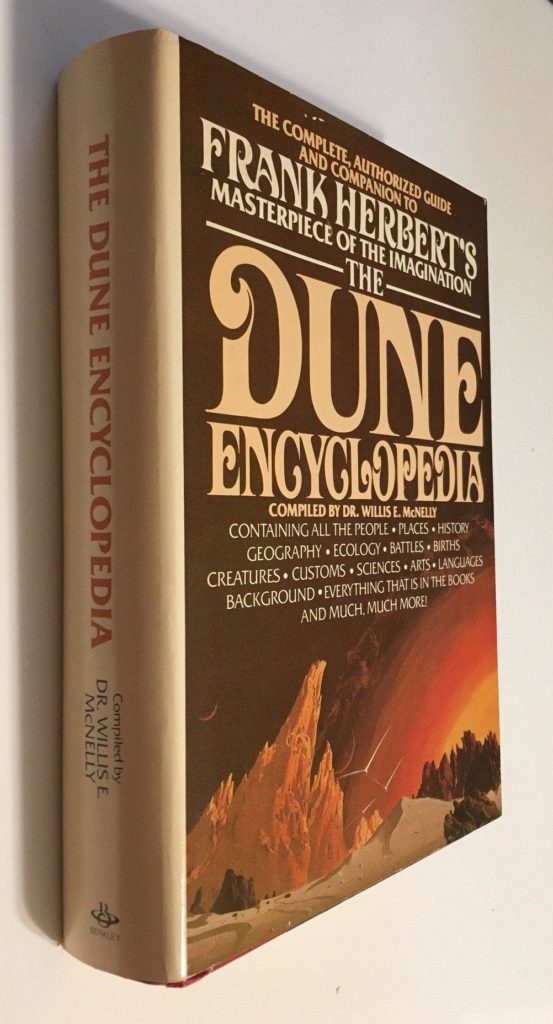
(13) TODAY’S BIRTHDAYS.
[Compiled by Cat Eldridge.]
- Born June 1, 1926 — Andy Griffith. His most notable SFF genre credit is as Harry Broderick on the late Seventies Salvage I which lasted for two short seasons. Actually that was it, other than a one-off on The Bionic Woman. It’s streaming for free on Crackle whatever the Frelling that is. (Died 2012.)
- Born June 1, 1928 — Janet Grahame Johnstone, and Anne Grahame Johnstone. British twin sisters who were children’s book illustrators best remembered for their prolific artwork and for illustrating Dodie Smith’s The Hundred and One Dalmatians. They were always more popular with the public than they were with the critics who consider them twee. (Janet died 1979. Anne died 1988.)
- Born June 1, 1940 — René Auberjonois. Odo on DS9. He’s shown up on a number of genre productions including Wonder Woman, The Outer Limits, Night Gallery, The Bionic Woman, Batman Forever, King Kong, Star Trek VI: The Undiscovered Country, Enterprise, Stargate SG-1 and Warehouse 13. He’s lent both his voice and likeness to gaming productions in recent years, and has done voice work for the animated Green Lantern and Justice League series. He directed eight episodes of DS9. And he wrote a lot of novels, none of which I’ve read. Has anyone here read any of them? (Died 2019.)
- Born June 1, 1947 — Jonathan Pryce, 75. I remember him best as the unnamed bureaucrat in The Adventures of Baron Munchausen. He’s had a long career in genre works including Brazil, Something Wicked This Way Comes as Mr. Dark himself, Pirates of the Caribbean: The Curse of the Black Pearl and Pirates of the Caribbean: At World’s End as Governor Weatherby Swann, The Brothers Grimm, in the G.I. Joe films as the U.S. President and most recently in The Man Who Killed Don Quixote as Don Quixote.
- Born June 1, 1948 — Powers Boothe. Though not genre, he played saloon owner Cy Tolliver on the Deadwood series, and “Curly Bill” Brocius in Tombstone, one of my favorite films. Now genre wise, he’s in the animated Superman: Brainiac Attacks voicing Lex Luthor, The Avengers as Gideon Malick, Gorilla Grodd and Red Tornado in Justice League and Justice League Unlimited and a recurring role as Gideon Malick in the Agents of S.H.I.E.L.D. series. (Died 2017.)
- Born June 1, 1954 — Michael P. Kube-McDowell, 68. A filker which gets major points in my book. And yes, I’m stalling while I try to remember what of his I’ve read. I’m reasonably sure I’ve read both of his Isaac Asimov’s Robot City novels, and now I can recall reading Alternities as well. God, it’s been at least twenty years since I read him which I thought odd, but then I noticed at ISFDB that he hasn’t published a novel in that long.
- Born June 1, 1966 — David Dean Oberhelman. Another one who died far too young. Mike has an appreciation of him here. The Intersection of Fantasy and Native America: From H.P. Lovecraft to Leslie Marmon Silko which he co-wrote with Amy H. Sturgis was published by The Mythopoeic Press. ISFDB lists just one genre essay by him, “From Iberian to Ibran and Catholic to Quintarian”, printed in Lois McMaster Bujold: Essays on a Modern Master of Science Fiction and Fantasy. (Died 2018.)
- Born June 1, 1996 — Tom Holland, 26. He’s known for playing Spider-Man in five films: Captain America: Civil War, Spider-Man: Homecoming, Avengers: Infinity War, Avengers: Endgame, and the recently out Spider-Man: Far From Home.
(14) IT’S GOT ISSUES. At The Verge, Alex Cranz says, “The merging of Comixology and Kindle has created a hell I’d like to escape”.
In February of this year, Amazon finally completed its consumption of the once independent app for downloading comics, Comixology. Amazon had acquired the app way back in 2013, and apart from removing the ability to buy comics directly from the app, it left it untouched for nearly a decade. But this year, Amazon changed things — incorporating Comixology’s digital marketplace directly into the Kindle ecosystem and totally redesigning the Comixology app. It has taken two distinct mediums — digital comics and digital books — and smashed them together into an unholy blob of content that is worse in every single way. Apparently, if you let one company acquire a near-monopoly in the digital books and comics spaces, it will do terrible things that make the experience worse….
…The new Comixology app is largely just… annoying. That’s the best word for it. Everything you need is still there, but the design isn’t really intuitive, and it can make a large collection of comics (I’ve been using Comixology since 2011) difficult to navigate. It feels sort of like when you go to the grocery store after they move aisles around. Everything is still there, but the change feels so dramatic after years of the familiar.
But where my local Food Bazaar will helpfully label the aisles, Comixology has not. There are no clear labels for useful built-in tools like its “Guided View,” which is designed to fluidly move you from panel to panel with a swipe instead of having each page take up the whole display. The Guided View is still there, but the clear explanation of what it is or how to use it is gone. You access it by double-tapping — which I only know because I was trying to access the menu to leave the book.
(15) CONFRONTING THE BLANK PAGE. Neil Clarke wrestles with the question of what he should be doing in his monthly Clarkesworld editorial: “Managing This Expectation”. He posits several ideas – here are two of them.
…Or perhaps, I’m filing a report of “criminal” acts? Earlier this week I was the victim of an ageist attack suggesting that I was “too old to be editing one of the leading science fiction magazines” and I should “get out of the way” so someone younger can do it. I’m only fifty-five, not the oldest editor I know, and not about to give up the magazine I started over one person’s disrespectful opinion on the matter. Their punishment is measured by the amount of time I continue to edit Clarkesworld.
Could be that it’s like being a referee, outlining how we’d like to see the game played? It’s perfectly fair to criticize or celebrate the finalists or winners of any award. Science fiction is a broad field with a variety of styles that might not appeal to everyone and the awards will reflect some of that. It’s only natural to be thrilled or disappointed when your favorite player wins, loses, or is benched. That said, we want a fair fight here. There should be no punching below the belt–criticizing or campaigning against based on anything other than the work they’ve done….
(16) FANTASY ART ON EXHIBIT. [Item by Bill.] The Hunter Museum of Art in Chattanooga, TN is holding this exhibition through September 5: “Enchanted: A History of Fantasy Illustration”.
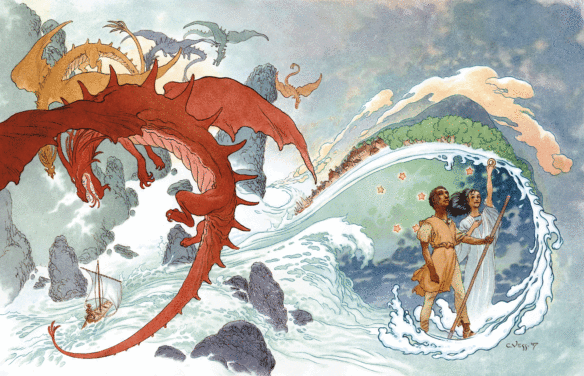
For hundreds of years, artists have been inspired by the imaginative potential of fantasy. Unlike science fiction, which is based on fact, fantasy presents an impossible reality—a universe where dragons breathe fire, angels battle demons, and magicians weave spells. Enchanted offers a thoughtful appraisal of how artists from the early 20th century to the present have brought to life myths, fairy tales, and modern epics like Lord of the Rings and Game of Thrones. Featuring nearly 100 artworks, the exhibition explores Greek myths, Arthurian Legends, fairy tales, and modern superheroes.
The Hunter’s description of the event isn’t much, and a better one can be found here at the Norman Rockwell Museum, which organized the event.
There is an accompanying book available from Amazon and Bud’s Art Books.
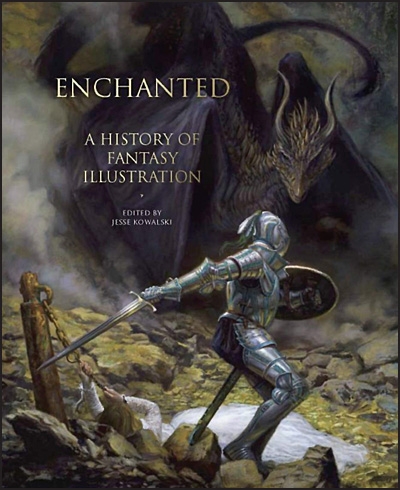
If you can’t make it to Chattanooga, the exhibition is also travelling to Flint, MI and will be on display at the Flint Institute of Arts from September 24, 2022 – January 8, 2023.
(17) SOME CAN AND SOME CANTON. Camestros Felapton, in “Some Swiss news about far-right publisher Vox Day”, covers Vox Day’s announcement that he’s threatening to sue [Internet Archive link] the journalists who reported his purchase of a Swiss castle.
The journalists’ article includes this paragraph:
…On the internet, Vox Day summarizes the alt-right – to which he avoids being directly attached – as the defense of “the existence of the white man and the future of white children”. The blogger also confesses a certain admiration for Adolf Hitler. “National Socialism is not only human logic, it is also much more logical and true than communism, feminism or secular Zionism,” the Minnesota-born American writes on his blog. …
Vox always objects to being identified with Hitler and Nazis (see “Complaint About Term ‘Neo-Nazi’ Results in Foz Meadows Post Moving from Black Gate to Amazing Stories” from File 770 in 2016).
(18) YOUR VIEWING PLEASURE. JustWatch determined these were the “Top 10 Sci-Fi Movies and TV Shows in the US in May 2022”
| Rank* | Movies | TV shows |
| 1 | Spider-Man: No Way Home | Star Trek: Strange New Worlds |
| 2 | Sonic the Hedgehog 2 | Obi-Wan Kenobi |
| 3 | Morbius | Severance |
| 4 | Ghostbusters: Afterlife | Stranger Things |
| 5 | Moonfall | Doctor Who |
| 6 | Firestarter | Moon Knight |
| 7 | Jurassic World: Fallen Kingdom | The Man Who Fell to Earth |
| 8 | Jurassic World | The Time Traveler’s Wife |
| 9 | The Batman | Halo |
| 10 | Sonic the Hedgehog | The Twilight Zone |
*Based on JustWatch popularity score. Genre data is sourced from themoviedb.org
(19) BAGEL POWER. Accented Cinema is prepared to tell you “The Hidden Meaning of Everything Everywhere All at Once”.
Here it is! My analysis of the metaphors hidden in Everything Everywhere At at Once. Did you know why Michelle Yeoh put a googly eye on herself? Let’s find out!
(20) VIDEO OF THE DAY. [Item by Martin Morse Wooster.] In “Honest Game Trailers: Vampire: The Masquerade: Bloodhunt,” Fandom Games says while earlier installments of this franchise “turned a bunch of nerds into enerds wearing eye shadow,” this installment is “the latest in the ‘kill people in a rapidly shrinking circle genre.” The narrator thinks the game is boring and says, “call me when Bloodhunt has Ariana Grande and industrial dancing!”
[Thanks to Cat Eldridge, Mike Kennedy, Martin Morse Wooster, JJ, Bill, N., John King Tarpinian, Chris Barkley, Andrew Porter, and Michael Toman for some of these stories. Title credit belongs to File 770 contributing editor of the day Maytree.]

